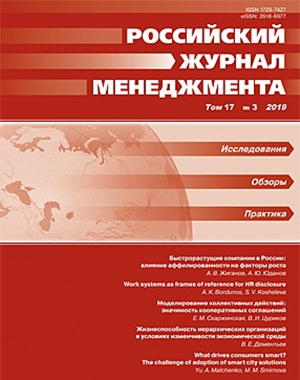Work Systems as Frames of Reference for HR Disclosure
DOI:
https://doi.org/10.21638/spbu18.2019.302Аннотация
The paper focuses on the challenge of coding and interpreting the human resource disclosures. Treating disclosed signals as positive or negative depends on the implicit contextual frames of reference. Such frames represent a combination of legitimate human resource practices, processes, initiatives, values and beliefs. The research explores applicability of human resource management systems, also known as work systems, within the confines of such frames. Additional attention is paid to the reasons of variety in the human resource disclosures and the rationale of preferring one work system over the other despite limited freedom of choice among available standards. Through analysis of the content, extent and quality of the employees-related disclosure by 18 top banks in Russia for the 2016 period, the research discusses opportunities and barriers of work systems as the frames of reference for HR disclosure. Research design relies on thematic and content analysis to compare existing standards with the ones proposed by the strategic human resource management literature.
Ключевые слова:
annual reports, disclosure, discourse analysis, high-commitment work system, high-involvement work system, high-performance work system, human resource management
Скачивания
Библиографические ссылки
REFERENCES
Загрузки
Опубликован
Как цитировать
Выпуск
Раздел
Лицензия
Статьи журнала «Российский журнал менеджмента» находятся в открытом доступе и распространяются в соответствии с условиями Лицензионного Договора с Санкт-Петербургским государственным университетом, который бесплатно предоставляет авторам неограниченное распространение и самостоятельное архивирование.





